George, that is really interesting about the Cape/Leven confusion at the Creek. As you know, Whigham described the Cape and Leven as being based on the same principle but wrote that the application was "a little different." The difference (at NGLA at least) was that on the Cape the long hitter could play more directly at the green, but too short of shot on this line would leave an approach from a very difficult angle. In contrast, because of the dune/mounding and nature of the green on the Leven, the better play for the longer hitter was to play play more away from the green to open the green up from the side. (Because of the diagonal carry off the tee on
the Leven, the shorter hitter had no choice but to play more toward the hole, and then face a shot from a tough angle over the dune/mounding for a second.
____________________________________________________
There is always a lot of speculation and guessing about what is a Cape hole. I've always found this a bit odd because CBM and HJW described the hole in detail. My guess it is gets confused because the original Cape at NGLA was modified and the namesake feature lost.
A few years ago I tried to pull together some information on the original concept and update the information periodically when the issue comes up. Hopefully some will find it helpful . . .
Original Understanding of the "Cape Hole."As George Bahto notes in his excellent book, Macdonald's understanding of the hole was quite specific. Macdonald's and Whigham's 1914 Golf Illustrated article on on the Cape (in their all too brief
Representative American Golf Holes series) leaves no doubt about what they considered a Cape Hole:
"The fourteenth hole at the National Golf Links is called the Cape Hole, because the green extends out into the sea with which it is surrounded upon three sides." On other words, the hole is named after the geographic feature. Here is a stitched photo of the plasticine model of the original hole, from the article mentioned above:
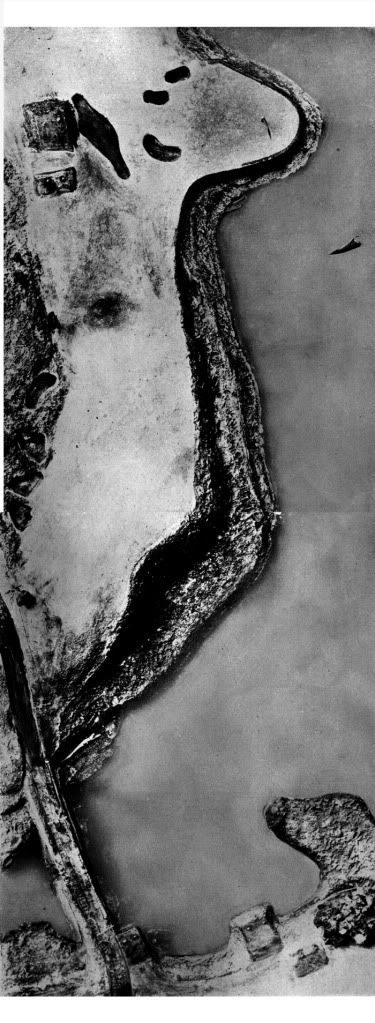
H.J. Whigham offered a very good description of the fundamental strategic principles underlying the hole in his 1909 Scribner's article:
"The same principle [as at the Sahara] is applied at the 5th hole, which will be perhaps the most celebrated in the country. The actual distance from tee to flag is about 290 yards—one would have said the worst possible distance for a hole—but it works out beautifully. The hazard in this case is water. Here it is impossible quite to reach the green, but the fine driver if he likes to take a risk and go almost straight for the hole, may get within putting distance and so have a good chance for a three. But the least slice will carry his ball into Sebonac Creek; or if he fails to get 240 yards he will have a difficult little pitch shot onto the promontory. The man who can drive 200 yards may prefer to play fairly well to the left so as to be sure of opening the hole; but then he has a long approach onto the promontory. Finally, the short driver can get across the water by playing well to the left and carrying less than 100 yards; but he has a long second to play and may easily take a five. In fact, the hole is either a three or a four or a five, according to the way the tee shot is played."Whigham's diagram of the tee options from his 1909 Scribner's article:
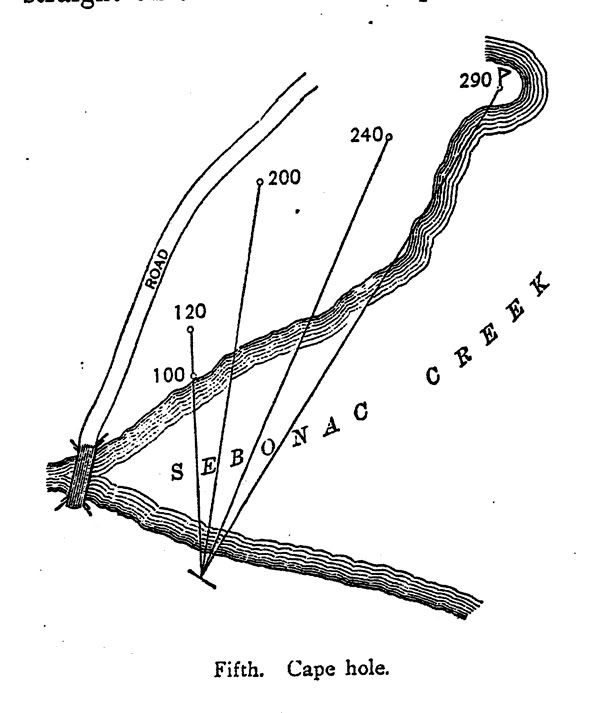 The Modern Conception: A Dumbed Down Cape.
The Modern Conception: A Dumbed Down Cape.As Macdonald described in Scotland's Gift (and as George succinctly reports in his terrific book) the Cape hole lost its cape green not long after its creation. This left the hole with a diagonal carry off the tee where one could get closer to the green the more one cut off, and perhaps this accounted for the eventual change in understanding of the concept. Now almost any sort of hole with a diagonal carry off the tee is called a Cape Hole. The golfer has a choice of how much of the diagonal to cut off. The more he cuts off, the less he has left to the green.
In my opinion we've lost some things in translation and/or transition. While some of Macdonald's Capes had a diagonal carry over trouble (Mid-Ocean and NGLA most notably) there was more to the hole than just cutting of distance. The trick was understanding one's abilities and executing one's shot to not only get close, but also to get
the best angle into the green on the next shot. And there was no single "best" place to be, for the best place was entirely dependent upon the length of one's drive.
For example, at NGLA's Cape the most daring angle along the water might easily stay dry but still leave the shorter hitter but the worst angle of attack to a difficult green surrounded by trouble on three sides. A long drive would open up the green
and leave a short chip or long putt (from off the green.) but, as HJW put it, "
if he fails to get 240 yards [the distance necessary to start to open up the green if one took the more direct line along the water] he will have a difficult little pitch shot onto the promontory." Conversely a less daring but well placed shot away from the trouble might leave the shorter hitter a longer shot but a much better angle, while the safest carry and shortest shot might leave the longest shot and a difficult angle. [If I recall correctly, George noted that some cape greens favored the angle more from the outside while some (Mid Ocean?) favored the angle from more inside.]
So it wasn't just about cutting off as much as possible to get closer to the hole.
It was about balancing the temptation of getting as close with the restraint of knowing one's game and choosing the best line and angle. And then of course the golfer had to execute, and not just on the drive. Now, like many of our supposed "strategic options" the concept of the cape has been dumbed down to simply cutting a corner to get a shorter shot in.
Other Applications of the Original Cape Concept.Many prominent designers and course builders adopted Macdonald's and Whigham's definition and their "cape" terminology, although they obviously often substituted bunkers or other trouble the water surrounding three sides. CBM, Raynor, and apparently Banks built many to fit this mold. In the mid-20's when increasing traffic on Ardmore Avenue necessitated the change, Wilson replaced the CBM-style "Alps" 10th at Merion East with a CBM-style "Cape" hole. Flynn adopted the CBM/HJW definition and noted that it was one of his three basic hole concepts for par fours (along with the elbow and dogleg,) Tillinghast did so as well.
While the original Cape Hole at NGLA was unfortunately modified (and Cape green lost) to make room for the road, there may arguably be many other fine early examples of the concept in the ground, including a short par four 12th at Pine Valley which reportedly fits the mold. While I am not sure he identified it as such, Thomas built a heck of take on the cape hole concept at Riviera's 10th. I was struck at Prairie Dunes by how much the original 3rd (now the 6th) must have felt like a cape in the original sense, although incredibly Maxwell created this sensation using mostly contours. The 12th at Rustic is cape-like (in the original sense) but the back is guarded by nothing but ground slope away (and in ideal conditions nothing else is needed.) Other examples abound. It is really a terrific hole concept and works wonderfully on a short par 4, providing a fan of options where oftentimes the full consequences of the drive are not fully felt until the second.
Below are a diagram, description, and two photos depicting Merion's "so-called cape hole," the 10th. All are from the November 1925 USGA Green Section Record and part of the series on "Instructive Golf Holes." [One interesting aside is the measure of the hole is incorrectly listed as 335 yards. From the tee in the photos, the hole was over 50 yards shorter than that.]
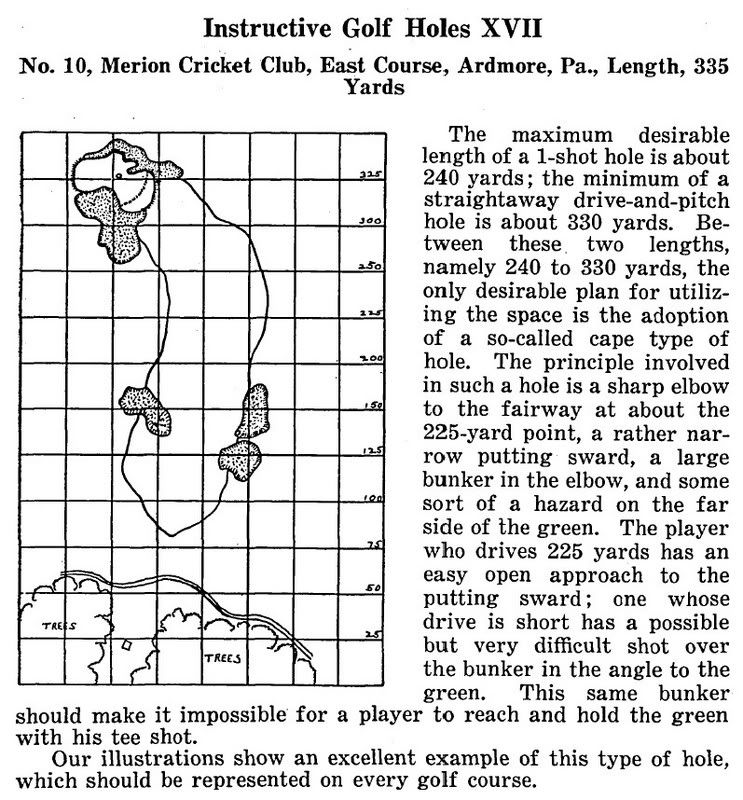
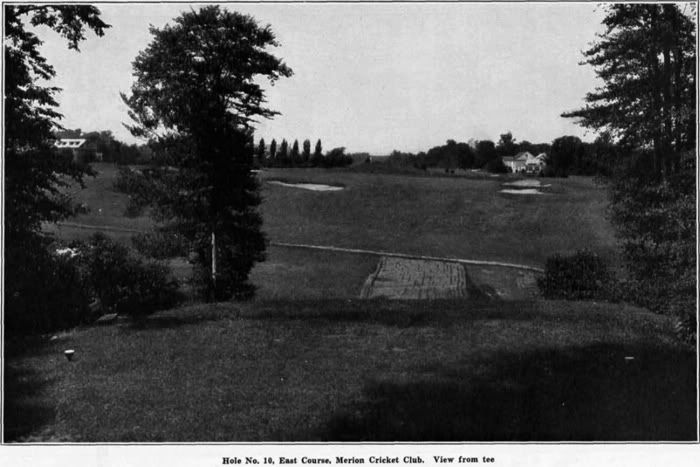
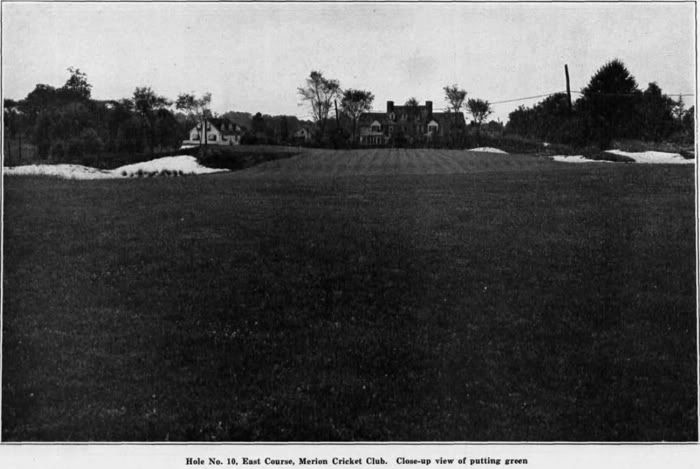 Was the Diagonal Carry Integral to the Cape Concept
Was the Diagonal Carry Integral to the Cape Concept?
Again, remember that CB Macdonald did not mince words when he described the Cape concept. Here again are those words:
"The fourteenth hole at the National Golf Links is called the Cape Hole, because the green extends out into the sea with which it is surrounded upon three sides." So why is it so hard for some to take him at his word?
So the Short Answer is : No. While the two most famous Capes do feature diagonal carries, these carries were only around 150 yards the longest. So while these may have been scary carries for all, they were only strategically significant to short hitters.[/i] Other of CBM's early versions of the concept, such as at St. Louis, Yale, and the Lido, did not feature this type of diagonal carry.
1.
NGLA and Mid Ocean.
With today's insane technology, it is easy to forget
the greens on Cape holes generally could not be carried from the tee. So when considering the "diagonal carry" we ought to be thinking of the actual, realistic, carry.
AT IT'S LONGEST, the diagonal carry at NGLA was 150 yards. From CBM in 1914:
"The shortest way over the water, a carry of 120 yards, is the longest way to the hole, whereas the shortest way to the hole is to the right, a carry of 150 yards." Likewise, at Mid Ocean the diagonal carry was about the same, around 150 yards
AT ITS LONGEST. So, again, for even the moderately competent hitter, making the carry was not really ever an issue. So while the capes at NGLA and Mid Ocean featured fairly short diagonal carries over over water, the actual diagonal carry was not long enough to be a key strategic component.
Here is a photo of the original Cape Hole" from the August 1910 American Golfer:
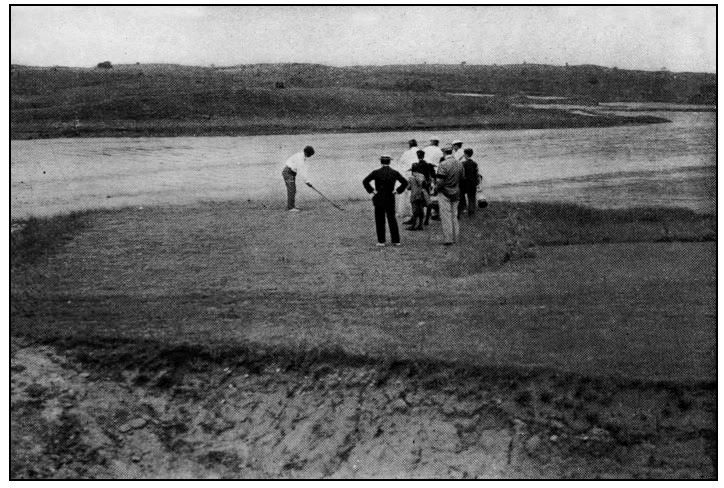
One from the fairway, 1914.
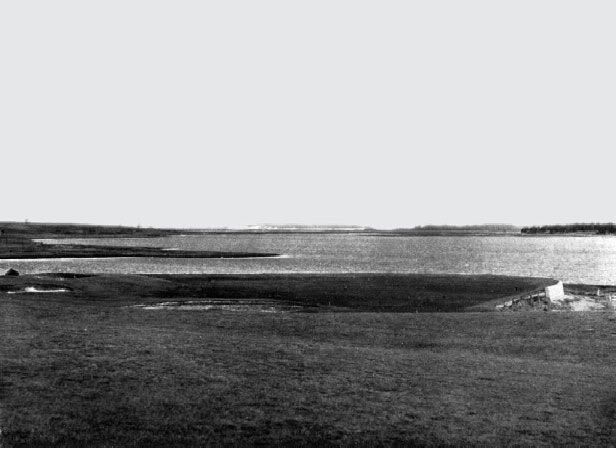
A slightly different angle, 1910.
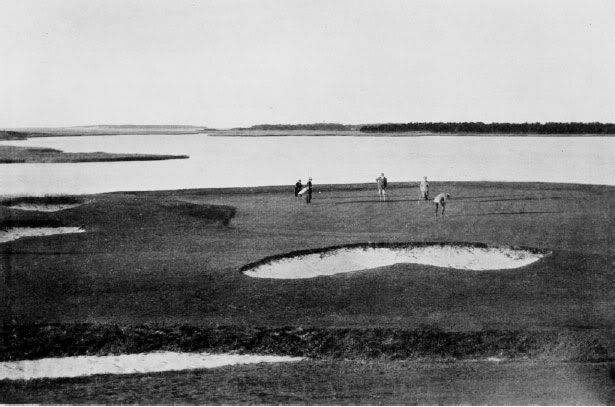
2.
St. Louis, Yale, and the Lido.
Some of Macdonald's Cape holes did not require a diagonal carry. There is no diagonal carry at Yale's Cape. St. Louis (1914) does have a carry over a creek of about 150 yards off the tee (probably shorter then.) but
the Cape at St. Louis does not feature a diagonal carry off the tee. Perhaps most telling is the Lido's Cape, because presumably CBM could have made the underlying strategic principles exactly as he wanted. Here is what CBM had to say about the hole in 1915:
"The fifth hole resembles the Cape hole at the National, but the bunkering and undulations probably make it a little more scientific than our Cape hole off the tee. One will always see however that it is the creation ofBut so far as I know man and not the creation of Nature, for it has, as most holes on this course have, the technical design of an architect rather than the inimitable design of nature." The Lido's Cape had
no diagonal carry off the tee, at least not anything like the diagonal at NGLA. There was an optional diagonal carry
away from the hole, but even here the carry is no more than 150 yards AT ITS LONGEST, and thus not an issue all but the very short hitter off the tee. Here is a photo of the plasticine model of the 320 yard hole.
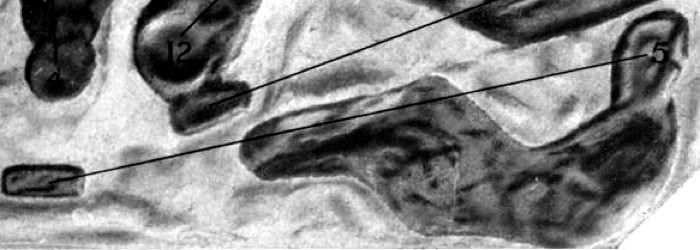
So it seems that he diagonal carry off the tee is not integral to the hole concept. While some cape holes feature a short diagonal carry, that carry is not really strategically significant to most golfers. Other Cape Holes do not feature a diagonal at all.